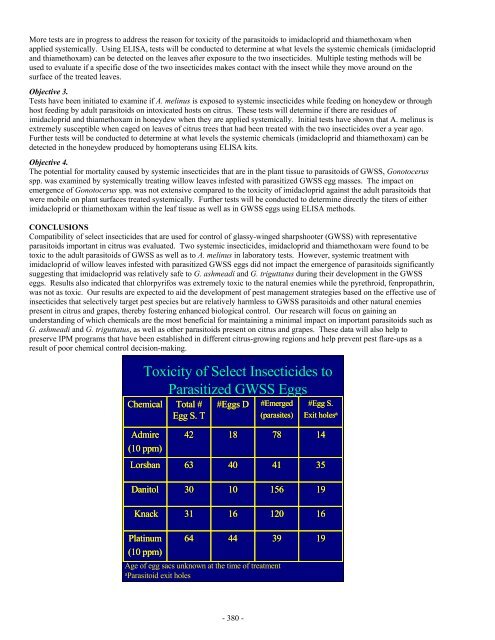Impact Of Host Plant Xylem Fluid On Xylella Fastidiosa Multiplication ...
Impact Of Host Plant Xylem Fluid On Xylella Fastidiosa Multiplication ...
Impact Of Host Plant Xylem Fluid On Xylella Fastidiosa Multiplication ...
You also want an ePaper? Increase the reach of your titles
YUMPU automatically turns print PDFs into web optimized ePapers that Google loves.
More tests are in progress to address the reason for toxicity of the parasitoids to imidacloprid and thiamethoxam when<br />
applied systemically. Using ELISA, tests will be conducted to determine at what levels the systemic chemicals (imidacloprid<br />
and thiamethoxam) can be detected on the leaves after exposure to the two insecticides. Multiple testing methods will be<br />
used to evaluate if a specific dose of the two insecticides makes contact with the insect while they move around on the<br />
surface of the treated leaves.<br />
Objective 3.<br />
Tests have been initiated to examine if A. melinus is exposed to systemic insecticides while feeding on honeydew or through<br />
host feeding by adult parasitoids on intoxicated hosts on citrus. These tests will determine if there are residues of<br />
imidacloprid and thiamethoxam in honeydew when they are applied systemically. Initial tests have shown that A. melinus is<br />
extremely susceptible when caged on leaves of citrus trees that had been treated with the two insecticides over a year ago.<br />
Further tests will be conducted to determine at what levels the systemic chemicals (imidacloprid and thiamethoxam) can be<br />
detected in the honeydew produced by homopterans using ELISA kits.<br />
Objective 4.<br />
The potential for mortality caused by systemic insecticides that are in the plant tissue to parasitoids of GWSS, Gonotocerus<br />
spp. was examined by systemically treating willow leaves infested with parasitized GWSS egg masses. The impact on<br />
emergence of Gonotocerus spp. was not extensive compared to the toxicity of imidacloprid against the adult parasitoids that<br />
were mobile on plant surfaces treated systemically. Further tests will be conducted to determine directly the titers of either<br />
imidacloprid or thiamethoxam within the leaf tissue as well as in GWSS eggs using ELISA methods.<br />
CONCLUSIONS<br />
Compatibility of select insecticides that are used for control of glassy-winged sharpshooter (GWSS) with representative<br />
parasitoids important in citrus was evaluated. Two systemic insecticides, imidacloprid and thiamethoxam were found to be<br />
toxic to the adult parasitoids of GWSS as well as to A. melinus in laboratory tests. However, systemic treatment with<br />
imidacloprid of willow leaves infested with parasitized GWSS eggs did not impact the emergence of parasitoids significantly<br />
suggesting that imidacloprid was relatively safe to G. ashmeadi and G. triguttatus during their development in the GWSS<br />
eggs. Results also indicated that chlorpyrifos was extremely toxic to the natural enemies while the pyrethroid, fenpropathrin,<br />
was not as toxic. Our results are expected to aid the development of pest management strategies based on the effective use of<br />
insecticides that selectively target pest species but are relatively harmless to GWSS parasitoids and other natural enemies<br />
present in citrus and grapes, thereby fostering enhanced biological control. Our research will focus on gaining an<br />
understanding of which chemicals are the most beneficial for maintaining a minimal impact on important parasitoids such as<br />
G. ashmeadi and G. triguttatus, as well as other parasitoids present on citrus and grapes. These data will also help to<br />
preserve IPM programs that have been established in different citrus-growing regions and help prevent pest flare-ups as a<br />
result of poor chemical control decision-making.<br />
Toxicity of Select Insecticides to<br />
Parasitized GWSS Eggs<br />
Chemical<br />
Total #<br />
Egg S. T<br />
#Eggs D<br />
#Emerged<br />
(parasites)<br />
#Egg S.<br />
Exit holes a<br />
Admire<br />
(10 ppm)<br />
42<br />
18<br />
78<br />
14<br />
Lorsban<br />
63<br />
40<br />
41<br />
35<br />
Danitol<br />
30<br />
10<br />
156<br />
19<br />
Knack<br />
31<br />
16<br />
120<br />
16<br />
Platinum<br />
(10 ppm)<br />
64<br />
44<br />
39<br />
Age of egg sacs unknown at the time of treatment<br />
a<br />
Parasitoid exit holes<br />
19<br />
- 380 -











